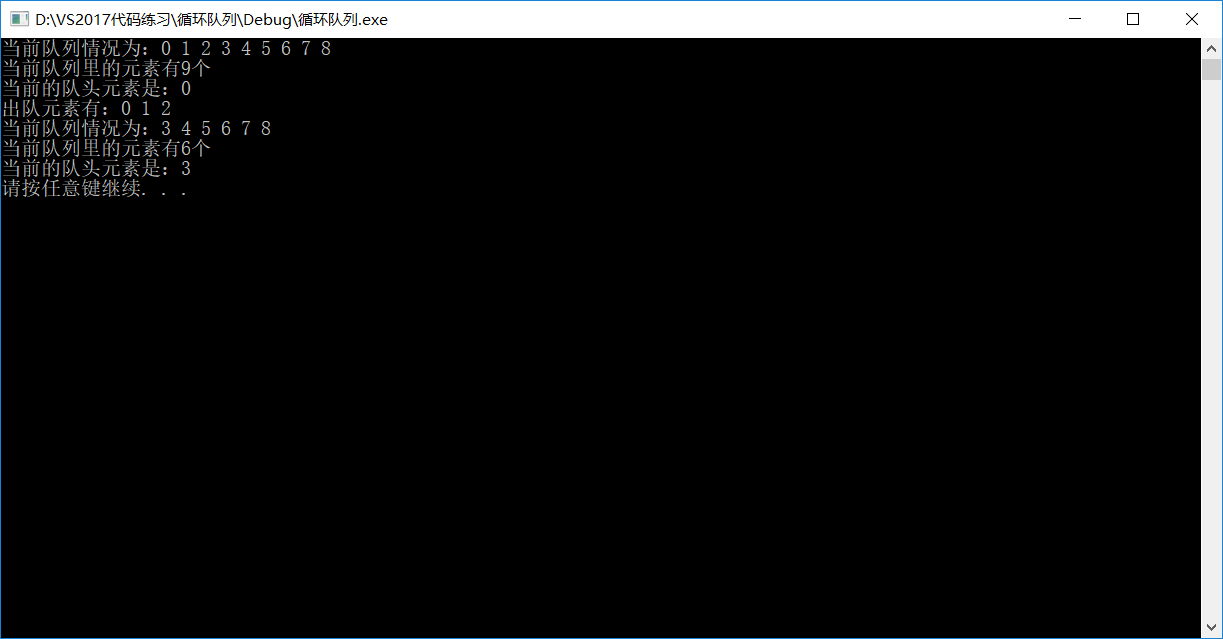1 #include<iostream> 2 #include<stdlib.h> 3 using namespace std; 4 5 typedef int QElemType; 6 typedef int Status; 7 #define MAXSIZE 10 8 #define OVERFLOW -2 9 #define OK 1 10 #define ERROR 0 11 12 //循环队列的存储结构 13 typedef struct 14 { 15 QElemType *base; //存储空间的基地址 16 int front; //头指针 17 int rear; //尾指针 18 }SqQueue; 19 20 //循环队列的初始化 21 Status InitQueue(SqQueue &Q) 22 { 23 Q.base = new QElemType[MAXSIZE]; //为队列分配一个最大容量为MAXSIZE的数组空间 24 25 if (!Q.base) //分配失败 26 exit(OVERFLOW); 27 28 Q.front = Q.rear = 0; //头指针和尾指针置为0,对列为空 29 30 return OK; 31 } 32 33 //队列长度 34 int QueueLength(SqQueue Q) 35 { 36 return (Q.rear - Q.front + MAXSIZE) % MAXSIZE; //循环队列,取余 37 } 38 39 //入队 40 //插入元素e,作为队列Q的新的队尾元素 41 Status EnQueue(SqQueue &Q, QElemType e) 42 { 43 if ((Q.rear + 1) % MAXSIZE == Q.front) //尾指针在循环意义上加1后等于头指针,表明对满 44 return ERROR; 45 46 Q.base[Q.rear] = e; //新元素插入队尾 47 48 Q.rear = (Q.rear + 1) % MAXSIZE; //队尾指针加1 49 50 return OK; 51 } 52 53 //出队 54 //删除Q的队头元素,用e返回其值 55 Status DeQueue(SqQueue &Q, QElemType &e) 56 { 57 if (Q.front == Q.rear) //队空 58 return ERROR; 59 60 e = Q.base[Q.front]; //保存队头元素 61 62 Q.front = (Q.front + 1) % MAXSIZE; //出队,队头指针加1 63 64 return OK; 65 } 66 67 //取队头元素 68 //返回队头元素,不修改头指针 69 QElemType GetHead(SqQueue Q) 70 { 71 if (Q.front != Q.rear) //队列非空 72 return Q.base[Q.front]; 73 } 74 75 int main() 76 { 77 int i, e; 78 int len; 79 SqQueue Q; 80 81 InitQueue(Q); //初始化一个空队列 82 83 for (i = 0; i < MAXSIZE; i++) 84 EnQueue(Q, i); //入队 85 86 len = QueueLength(Q); 87 88 cout << "当前队列情况为:"; 89 90 for (i = Q.front; i < Q.rear; i++) 91 { 92 cout << Q.base[i] << " "; 93 } 94 cout << endl; 95 96 cout << "当前队列里的元素有" << len << "个" << endl; 97 98 cout << "当前的队头元素是:" << GetHead(Q) << endl; 99 100 cout << "出队元素有:"; 101 for (i = 0; i < 3; i++) 102 { 103 DeQueue(Q, e); //出队 104 cout << e << " "; 105 } 106 cout << endl; 107 108 len = QueueLength(Q); 109 110 cout << "当前队列情况为:"; 111 112 for (i = Q.front; i < Q.rear; i++) 113 { 114 cout << Q.base[i] << " "; 115 } 116 cout << endl; 117 118 cout << "当前队列里的元素有" << len << "个" << endl; 119 120 cout << "当前的队头元素是:" << GetHead(Q) << endl; 121 122 system("pause"); 123 return 0; 124 }
